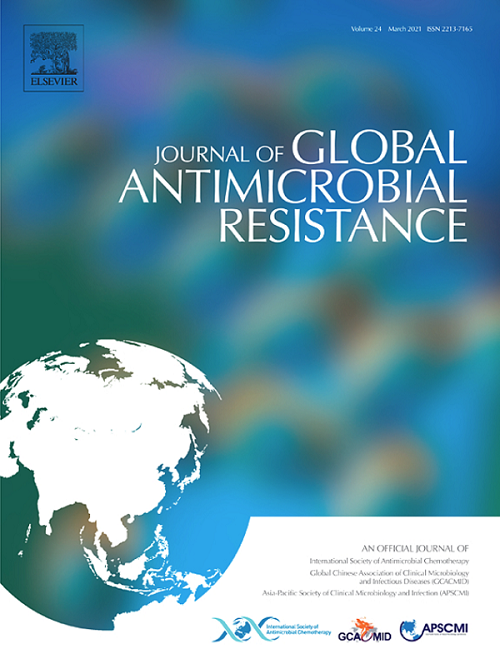Activity of aztreonam-avibactam and ceftazidime-avibactam against β-lactamase-producing enterobacterales Isolates from United States hospitals
IF 3.2
3区 医学
Q2 INFECTIOUS DISEASES
引用次数: 0
Abstract
Objectives
Enterobacterales isolates producing β-lactamases are widespread and threaten the use of β-lactams. This study evaluated the activity of aztreonam-avibactam and comparator antimicrobial agents against Enterobacterales isolates producing common β-lactamases collected in US hospitals.
Methods
A total of 18,148 Enterobacterales isolates collected during 2020–2021 in US hospitals (n = 71) were susceptibility tested by reference broth microdilution methods. A total of 2,337 isolates were submitted to whole genome sequencing due to elevated cephalosporins/aztreonam MIC values or carbapenem nonsusceptibility (meropenem and/or imipenem MIC results at >1 mg/L).
Results
ESBL enzymes were observed among 1,430 carbapenem-susceptible E. coli, K. pneumoniae, E. cloacae and Citrobacter spp. isolates and CTX-M-15 was the most common ESBL. Ceftazidime-avibactam inhibited all ESBL-producers while ceftolozane-tazobactam inhibited 68.4–95.9%. Aztreonam-avibactam inhibited >99.7% of the isolates regardless of the ESBL type or organism. Among other classes, amikacin and tigecycline were the most active agents, inhibiting 78.5% and 97.8% of the ESBL-producing isolates. All isolates carrying transferrable AmpC genes were susceptible to ceftazidime-avibactam and meropenem-vaborbactam, and 98.1% susceptible to aztreonam-avibactam, but only 83.3% were susceptible to ceftolozane-tazobactam. Five isolates carried blaCMY-42 with a PBP3 insertion and they exhibited aztreonam-avibactam MICs ranging from 2 to 16 mg/L. Among carbapenemase-producers (n = 157), aztreonam-avibactam, ceftazidime-avibactam and meropenem-vaborbactam susceptibility rates were 98.7%, 81.5% and 79.6%. The only comparator displaying activity against these isolates was tigecycline (93.0% susceptible).
Conclusions
New β-lactam/β-lactamase inhibitors were active against common β-lactamase-producing isolates from US hospitals, including carbapenemase-producing isolates for which therapeutic options are limited. Aztreonam-avibactam was the most active agent against carbapenemase producers, including MBL-carrying isolates.
氨曲南-阿维巴坦和头孢他啶-阿维巴坦对美国医院产β-内酰胺酶肠杆菌的活性研究
目的:产β-内酰胺酶的肠杆菌广泛存在,对β-内酰胺的应用构成威胁。本研究评估了氮曲南-阿维巴坦和比较抗菌药物对美国医院收集的产生常见β-内酰胺酶的肠杆菌分离株的活性。方法:采用参考肉汤微量稀释法对2020-2021年在美国各医院采集的18148株肠杆菌(71株)进行药敏试验。由于头孢菌素/氨曲南MIC值升高或碳青霉烯不敏感(美罗培南和/或亚胺培南MIC值为bbb10 ~ 1mg /L),共有2337株菌株进行了全基因组测序。结果:1430株碳青霉烯类敏感大肠杆菌、肺炎克雷伯菌、阴沟杆菌和柠檬酸杆菌分离株中检出ESBL酶,以CTX-M-15为最常见。头孢他啶-阿维巴坦对所有esbl产生菌均有抑制作用,而头孢噻嗪-他唑巴坦对esbl产生菌的抑制作用为68.4 ~ 95.9%。Aztreonam-avibactam对>的抑制率为99.7%,与ESBL类型和生物体无关。在其他种类中,阿米卡星和替加环素是最有效的药物,分别抑制78.5%和97.8%的esbl产生菌株。所有携带可转移AmpC基因的分离株对头孢他啶-阿维巴坦和美罗培尼-瓦波巴坦敏感,对唑曲南-阿维巴坦敏感的比例为98.1%,对头孢洛赞-他唑巴坦敏感的比例仅为83.3%。五个分离株进行blaCMY-42 PBP3插入和他们表现出aztreonam-avibactam麦克风从- 18 mg / L。碳青霉烯酶产生者(157例)中,唑曲南-阿维巴坦、头孢他啶-阿维巴坦和美罗培南-阿维巴坦的易感率分别为98.7%、81.5%和79.6%。唯一对这些分离株显示活性的比较物是替加环素(93.0%敏感)。结论:新的β-内酰胺/β-内酰胺酶抑制剂对美国医院常见的产生β-内酰胺酶的分离株有效,包括治疗选择有限的产生碳青霉烯酶的分离株。Aztreonam-avibactam对碳青霉烯酶产生菌最具活性,包括携带mbl的分离株。
本文章由计算机程序翻译,如有差异,请以英文原文为准。
求助全文
约1分钟内获得全文
求助全文
来源期刊

Journal of global antimicrobial resistance
INFECTIOUS DISEASES-PHARMACOLOGY & PHARMACY
CiteScore
8.70
自引率
2.20%
发文量
285
审稿时长
34 weeks
期刊介绍:
The Journal of Global Antimicrobial Resistance (JGAR) is a quarterly online journal run by an international Editorial Board that focuses on the global spread of antibiotic-resistant microbes.
JGAR is a dedicated journal for all professionals working in research, health care, the environment and animal infection control, aiming to track the resistance threat worldwide and provides a single voice devoted to antimicrobial resistance (AMR).
Featuring peer-reviewed and up to date research articles, reviews, short notes and hot topics JGAR covers the key topics related to antibacterial, antiviral, antifungal and antiparasitic resistance.
 求助内容:
求助内容: 应助结果提醒方式:
应助结果提醒方式:


